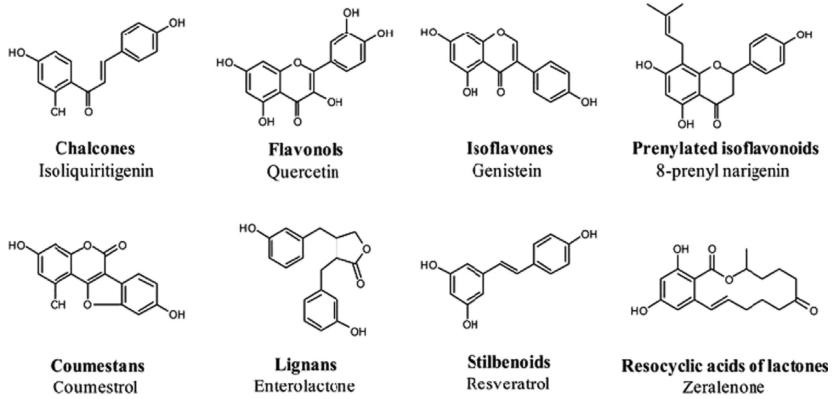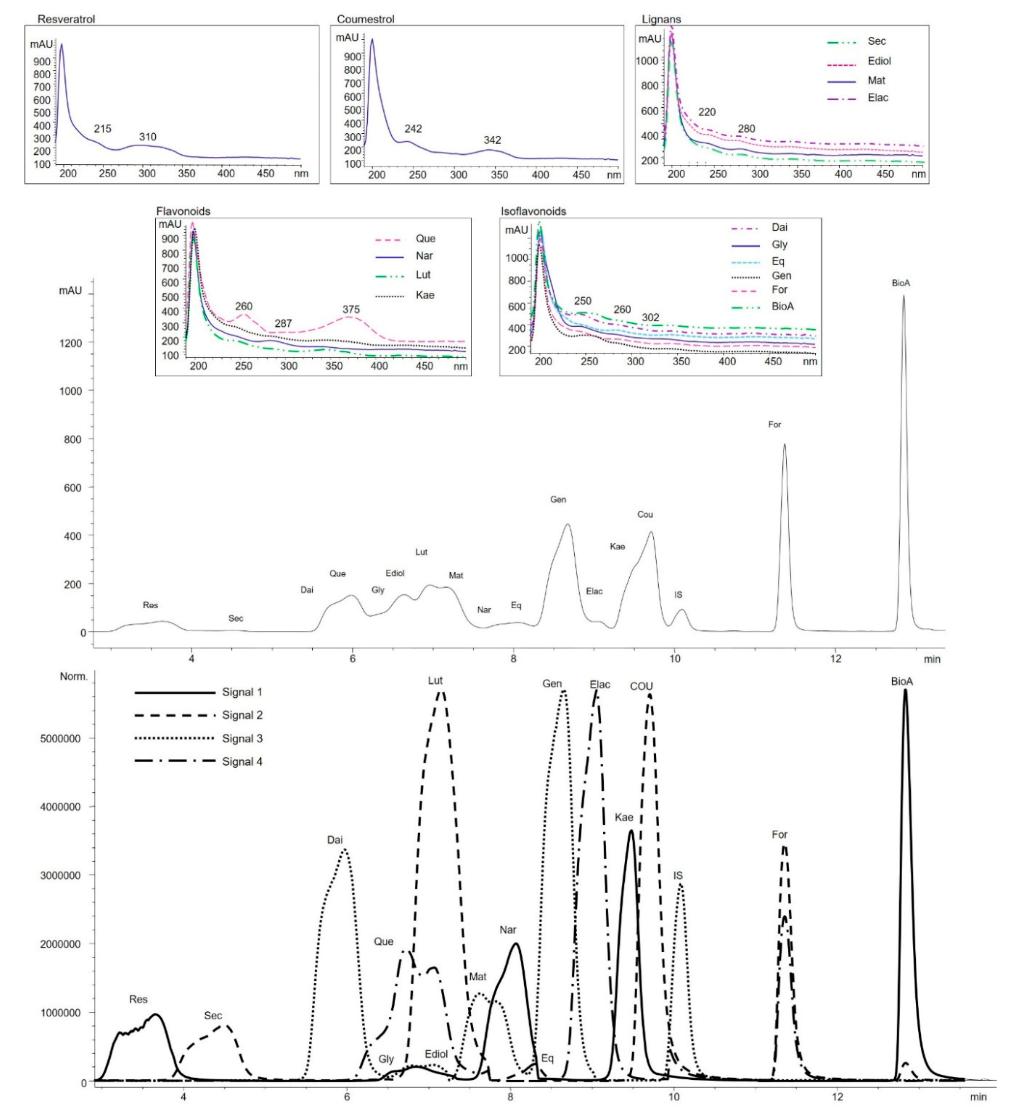What are Phytoestrogens?
Phytoestrogens are bioactive compounds found in plants that structurally resemble 17β-estradiol, the primary female sex hormone. These compounds can be classified into several categories, including isoflavones, lignans, coumestans, and stilbenes, each exhibiting varying degrees of estrogenic activity. Common dietary sources of phytoestrogens include soy products, flaxseeds, sesame seeds, and legumes. Due to their structural similarity to endogenous estrogens, phytoestrogens can interact with estrogen receptors α and β, modulating various physiological processes such as cell proliferation, apoptosis, and hormone regulation. The complex interplay between phytoestrogens and endogenous estrogens has spurred interest in their potential role in human health and disease.
 Molecular structure of the most ubiquitous phytoestrogens (Sirotkin et al., 2014)
Molecular structure of the most ubiquitous phytoestrogens (Sirotkin et al., 2014)
Phytoestrogens Analysis Offered by Creative Proteomics
Creative Proteomics offers a comprehensive suite of analytical services tailored to meet the diverse needs of researchers and industry professionals. Our portfolio encompasses a range of methodologies designed to quantify and characterize phytoestrogen content in various biological matrices, including food, supplements, and biological fluids. Key services include:
Quantification of Individual Phytoestrogens: Precise quantification of key phytoestrogens such as genistein, daidzein, equol, enterolactone, and resveratrol using high-performance liquid chromatography (HPLC) and mass spectrometry (MS).
Phytoestrogen Profiling: Comprehensive analysis of phytoestrogen profiles in various matrices, including food products, dietary supplements, plant extracts, biological fluids, tissue samples, and cell culture supernatant.
Metabolite Identification: Identification and characterization of phytoestrogen metabolites using advanced mass spectrometry techniques, including liquid chromatography-tandem mass spectrometry (LC-MS/MS) and high-resolution mass spectrometry (HRMS).
Estrogenic Activity Assessment: Evaluation of the estrogenic activity of phytoestrogen-containing samples using in vitro bioassays and receptor binding assays.
Customized Analytical Solutions: Tailored phytoestrogen analysis projects designed to address specific research questions and objectives.

Technological Platforms for Phytoestrogens Analysis
High-Performance Liquid Chromatography (HPLC)
Our HPLC-based assays employ the Agilent 1290 Infinity II LC System coupled with a Diode Array Detector (DAD) and fluorescence detector for precise quantification of individual phytoestrogens. This robust technique enables accurate separation and detection of target analytes, including genistein, daidzein, equol, enterolactone, and resveratrol, in complex matrices with exceptional sensitivity and specificity.
Gas Chromatography-Mass Spectrometry (GC-MS)
Utilizing the Thermo Scientific™ TSQ™ 8000 Evo Triple Quadrupole GC-MS System, Creative Proteomics delivers comprehensive analysis of volatile and thermally stable phytoestrogens and their metabolites. This technique facilitates precise identification and quantification, offering insights into phytoestrogen profiles and metabolic pathways in biological samples.
Enzyme-Linked Immunosorbent Assay (ELISA)
Our ELISA assays utilize the BioTek Epoch Microplate Spectrophotometer for rapid and cost-effective screening of phytoestrogen content in diverse sample cohorts. Leveraging highly specific antibodies, we deliver reliable quantitative data with minimal sample preparation.
Mass Spectrometry-Based Metabolomics
Creative Proteomics harnesses the Thermo Scientific™ Q Exactive™ HF-X Hybrid Quadrupole-Orbitrap™ Mass Spectrometer for comprehensive phytoestrogen metabolite profiling. Coupled with ultra-high-performance liquid chromatography (UHPLC), this cutting-edge platform facilitates simultaneous detection and identification of a wide range of phytoestrogen metabolites.
 Workflow for Plant Metabolomics Service
Workflow for Plant Metabolomics Service
Sample Requirements for Phytoestrogens Assay
| Sample Type |
Recommended Sample Volume |
| Food Products |
5-10 grams |
| Dietary Supplements |
1-5 grams |
| Plant Extracts |
1-5 milliliters (mL) |
| Biological Fluids |
0.5-1 milliliter (mL) |
| Tissue Samples |
20-50 milligrams (mg) |
| Cell Culture Supernatant |
0.5-1 milliliter (mL) |
Applications of Phytoestrogens Analysis
Nutritional Supplements: Commonly used to alleviate menopausal symptoms and support bone and cardiovascular health.
Cancer Prevention and Treatment: Studied for potential protective effects against breast, prostate, and colon cancer.
Skin Care Products: Included for antioxidant and anti-inflammatory properties, aiding in anti-aging effects.
Animal Feed Additives: Investigated for enhancing reproductive performance and health in livestock.
Environmental Remediation: Certain plants with phytoestrogens used to remediate soil and water contaminated with endocrine-disrupting chemicals.
Biomedical Research: Valuable for studying hormone-related diseases and physiological processes.
Functional Foods and Beverages: Used in soy-based foods and flaxseed products, offering convenient health benefits like cholesterol reduction.
Case. Method for Phytoestrogen Analysis in Food and Biofluids
Background
Phytoestrogens are bioactive compounds found in plants with potential health benefits. They mimic or modulate the effects of estrogen in the human body and have been linked to various health outcomes. Understanding their presence and concentrations in food and biofluids is crucial for assessing their impact on human health.
Sample
The study analyzed both food and biofluid samples. Food samples included commonly consumed items like turkey ham, beans, mandarins, and tomatoes. Biofluid samples comprised serum and urine from healthy individuals.
Technical Methods
The method employed liquid chromatography coupled with mass spectrometry (HPLC-MS) for the simultaneous quantification of 16 phytoestrogens. Optimization of chromatographic and mass spectrometric parameters allowed for effective separation, detection, and identification of phytoestrogens. The method utilized negative ion mode electrospray ionization (ESI) for increased sensitivity and lower fragmentation. Calibration curves were established to ensure linearity, and selectivity was enhanced by minimizing interferences. Solid-phase extraction and liquid-liquid extraction were employed for sample preparation, followed by chromatographic analysis using specific mass transitions for quantification.
Results
Phytoestrogen concentrations varied across food items, with notable levels found in turkey ham, beans, mandarins, and tomatoes.
Serum and urine samples showed varying phytoestrogen levels, with flavonoids predominating and levels influenced by seasonal fruit and vegetable intake.
The method demonstrated high sensitivity, selectivity, and accuracy, enabling simultaneous quantification of 16 phytoestrogens in food and biofluids.
Recoveries ranged from 66 to 113% in food, 63 to 104% in serum, and 76 to 111% in urine, with minor matrix effects observed.
The comprehensive method offers potential for large-scale epidemiological studies and the development of phytoestrogen databases, aiding in understanding their role in human health, particularly in diverse dietary contexts like North Mexico.
 Ultraviolet (UV) spectra, high-performance liquid chromatography (HPLC) and normalised-mass spectrometry (MS) chromatograms of the four mass-selective detector (MSD) signals of pure phytoestrogens standards (160 ng/mL) and internal standard (IS) in the injection solvent (methanol and initial mobile phase; v/v, 40/60).
Ultraviolet (UV) spectra, high-performance liquid chromatography (HPLC) and normalised-mass spectrometry (MS) chromatograms of the four mass-selective detector (MSD) signals of pure phytoestrogens standards (160 ng/mL) and internal standard (IS) in the injection solvent (methanol and initial mobile phase; v/v, 40/60).
 Representative MS chromatogram of the four MSD signals of a reagent blank (A) and a human blank serum (B) with internal standard.
Representative MS chromatogram of the four MSD signals of a reagent blank (A) and a human blank serum (B) with internal standard.
Reference
- Palma-Duran, Susana Alejandra, et al. "A comprehensive HPLC-DAD-ESI-MS validated method for the quantification of 16 phytoestrogens in food, serum and urine." Applied Sciences 10.22 (2020): 8147.


 Molecular structure of the most ubiquitous phytoestrogens (Sirotkin et al., 2014)
Molecular structure of the most ubiquitous phytoestrogens (Sirotkin et al., 2014)
 Workflow for Plant Metabolomics Service
Workflow for Plant Metabolomics Service Ultraviolet (UV) spectra, high-performance liquid chromatography (HPLC) and normalised-mass spectrometry (MS) chromatograms of the four mass-selective detector (MSD) signals of pure phytoestrogens standards (160 ng/mL) and internal standard (IS) in the injection solvent (methanol and initial mobile phase; v/v, 40/60).
Ultraviolet (UV) spectra, high-performance liquid chromatography (HPLC) and normalised-mass spectrometry (MS) chromatograms of the four mass-selective detector (MSD) signals of pure phytoestrogens standards (160 ng/mL) and internal standard (IS) in the injection solvent (methanol and initial mobile phase; v/v, 40/60). Representative MS chromatogram of the four MSD signals of a reagent blank (A) and a human blank serum (B) with internal standard.
Representative MS chromatogram of the four MSD signals of a reagent blank (A) and a human blank serum (B) with internal standard.

